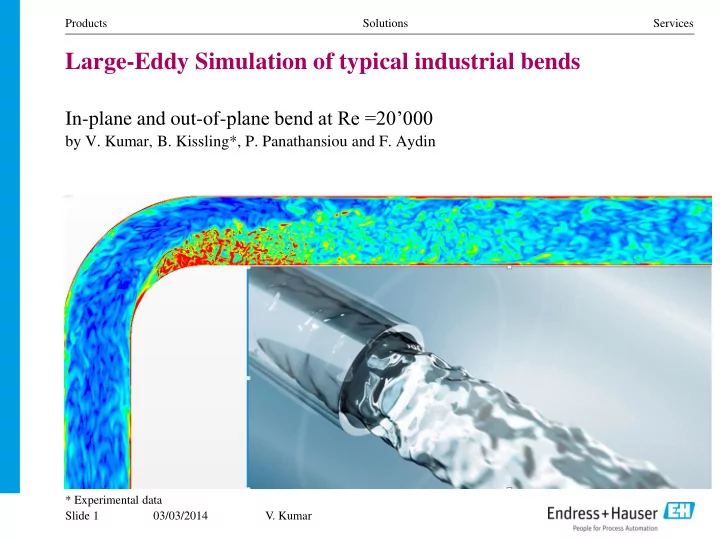

Products Solutions Services Large-Eddy Simulation of typical industrial bends In-plane and out-of- plane bend at Re =20’000 by V. Kumar, B. Kissling*, P. Panathansiou and F. Aydin * Experimental data Slide 1 03/03/2014 V. Kumar
Large-Eddy Simulation of flows after typical industrial bends E+H Flowtec AG Endress+Hauser Flowtec is a world leader in industrial flow meters Flow meters based on the principles Thermal, magnetic-inductive, vortex, ultrasonic and Coriolis Production centers in four continents Europe North America Asia Reinach-CH Cernay-Fr Greenwood / USA Suzhou / China Asia S. America Aurangabad / India Itatiba / Brazil Slide 2 03/03/2014 V. Kumar
Large-Eddy Simulation of flows after typical industrial bends Product Portfolio Line sizes from 1 mm to 3000 mm Promass ss 2 Line Display 4 Line Display Pushbutton Touch Control Promag Proso sonic c Flow Prowi wirl rl t-mass ss Slide 3 03/03/2014 V. Kumar
Large-Eddy Simulation of flows after typical industrial bends Where CFD is playing its role? Optimizing the design of the flow meters Flow meters can resolve effects of the order of 0.05% to 1% highly accurate models and high quality grids are required To investigate installation effects on the flow meters how does the flow develops after a disturbance Typical disturbances are bends, diffusors, reducers → It is very important for a turbulence model to accurately model the effects near the wall Slide 4 03/03/2014 V. Kumar
Large-Eddy Simulation of flows after typical industrial bends Bend Simulations Slide 5 03/03/2014 V. Kumar
Large-Eddy Simulation of flows after typical industrial bends Bend configurations investigated In-plane or 90° bend Out-of-plane bend Fully-developed inlet generated by a periodic pipe simulation Approx. 40D downstream length in the simulation LES, Realizable k-eps two-layer, RSM two-layer and SST models tested Measurements done using clamp-on ultrasonic sensors over the 0 to 360° at different L/D’s downstream the bends. Slide 6 03/03/2014 V. Kumar
Large-Eddy Simulation of flows after typical industrial bends Mesh For the LES simulation: G rid resolution 𝑠 + ≅ 15, 𝑨 + ≅ 30, 𝜄 + =15; ∆𝑧 + < 1, 𝑇𝑠 < 1.2 Base size => 0.015 D ∆𝑧 + is estimated from 𝑆𝑓 𝜐 = 0.199 𝑆𝑓 7/8 Approx. 10 Million Cells for both the cases → Mesh variation and boundary layer variations were also carried Slide 7 03/03/2014 V. Kumar
Large-Eddy Simulation of flows after typical industrial bends LES mesh size and effort requirement Computational effort goes with 𝑶 𝟐.𝟔 or 𝑺𝒇 𝟒.𝟘 10-20 Million cells grids are computationally affordable for LES ca. 2 days wall time with full 16 nodes, L/D~40 Affordable for industry Slide 8 03/03/2014 V. Kumar
Large-Eddy Simulation of flows after typical industrial bends LES Methodology Ratio of turbulent length scale and grid-size must be controlled A RANS simulation carried out before starting an LES k 3/2 ∆ 𝑆 𝑀 = ≤ 0.5, 𝑚 𝑢𝑣𝑠𝑐 = 𝑚 𝑢𝑣𝑠𝑐 ε CFL <1 in 96-99% cells Second order time- and space (BCD) discretization WALE Sub-grid model with wall-limiter and Cw =0.544 Simulations are carried until the averaged mean flow does not change anymore 100k time-steps with time-integration started after 20k steps. → Synthetic turbulence at the inlet to avoid laminarization Slide 9 03/03/2014 V. Kumar
Large-Eddy Simulation of flows after typical industrial bends In-Plane Bend Velocity field downstream in-plane bend • Flow development using RKEPS slowest among all • SST shows artifacts close to the bend • RSM is closest to LES • Same grid for LES and RANS Slide 10 03/03/2014 V. Kumar
Large-Eddy Simulation of flows after typical industrial bends Axial and radial velocity profiles • All RANS models predict much slower flow development for the in-plane bend Slide 11 03/03/2014 V. Kumar
Large-Eddy Simulation of flows after typical industrial bends Comparison with measurements • LDA Measurements by Kalpakli and Orlu, Int. J Heat and Fluid Flow 2013 at 0.67D Downstream the 90° bend • Reasonably well agreement between two independent studies Slide 12 03/03/2014 V. Kumar
Large-Eddy Simulation of flows after typical industrial bends Ultrasonic measurements vs Simulations 5D Downstream 30D Downstream • Deviation from mean flow velocity is plotted • LES shows a very good agreement throughout • RSM the best among RANS Slide 13 03/03/2014 V. Kumar
Large-Eddy Simulation of flows after typical industrial bends Out of plane bend at Re =20’000 • RSM gives artifacts • SST results are similar to RSM • Realizable k-epsilon model seems to be best performing • LES predicts different swirl decay than all RANS models Slide 14 03/03/2014 V. Kumar
Large-Eddy Simulation of flows after typical industrial bends Comparison with ultrasonic measurements-I • At 3D downstream • RKEPS-2L is underpredicting the flow distortion • LES is very close to the measurements • Both RSM and SST shows artificial effects → We performed transient RANS as well without much improvement Slide 15 03/03/2014 V. Kumar
Large-Eddy Simulation of flows after typical industrial bends Comparison with ultrasonic measurements-II • At 11 D downstream • RSM model seems to recover further downstream • In LES, swirl seems to be much faster, i.e. tangential stresses are under predicted → We tested various mesh sizes and different subgrid models Slide 16 03/03/2014 V. Kumar
Large-Eddy Simulation of flows after typical industrial bends Conclusions In-plane bend: • Both RSM and LES are well predicting the flow up to 30D downstream • Realizable K-Epsilon model predicts slower decay of disturbances • SST significantly worse than others Out-of-plane bend: • RANS are better predicting the rotational decay • Close to the bend, both RSM and SST are not performing well • LES is predicting very well close to the bend • However further downstream, swirl decay much slower than as predicted by RANS and in experiments • LES models and grid-resolution to be thoroughly investigated for swirling flows Slide 17 03/03/2014 V. Kumar
Large-Eddy Simulation of flows after typical industrial bends Thank you Vortictiy field in 90° bend Slide 18 03/03/2014 V. Kumar
Recommend
More recommend